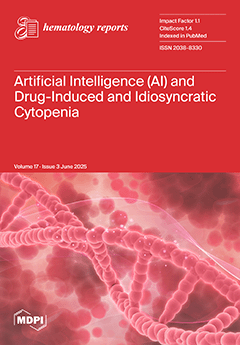Open AccessBrief Report
Clinical Outcome and Molecular Profile in Patients with DDX41 Mutation Hot-Spots
by
Nadia Toumeh, Yazan Jabban, Ahmad Nanaa, Rong He, David Viswanatha, Dragan Jevremovic, James M. Foran, Cecilia Y. Arana Yi, Antoine N. Saliba, Mehrdad Hefazi Torghabeh, William J. Hogan, Mithun V. Shah, Abhishek A. Mangaonkar, Mrinal M. Patnaik, Hassan B. Alkhateeb and Aref Al-Kali
Viewed by 1900
Abstract
Background/Objectives: DDX41, DEAD-box RNA helicase 41 gene located on chromosome 5q25.3, is one of the most mutated genes in patients with germline predisposition to myeloid neoplasms. Germline and somatic mutations often have different locations and patterns of mutation, with some hotspots
[...] Read more.
Background/Objectives: DDX41, DEAD-box RNA helicase 41 gene located on chromosome 5q25.3, is one of the most mutated genes in patients with germline predisposition to myeloid neoplasms. Germline and somatic mutations often have different locations and patterns of mutation, with some hotspots displaying diversity based on ethnicity. We aimed to explore clinical outcomes in patients with various
DDX41 hot-spot mutations.
Methods: This was a retrospective study of patients at Mayo Clinic with
DDX41 mutation identified through Next Generation Sequencing (NGS) between 2018 and 2024. We completed unadjusted comparisons using continuous or categorical variables, and survival rates were assessed using the Kaplan–Meier method and cox regression analysis.
Results: Overall survival appears to be higher in those with p.M1| when compared to p.Asp140GlyFs*2 and p.Arg525His, with comparable survival between p.Arg525His and p.Asp140GlyFs*2. Among males with p.M1| who underwent bone marrow transplant, those who underwent bone marrow transplant appeared to have lower survival rates, although not statistically significant. Our study was limited by a small sample size, therefore limiting our ability to reach significance.
Conclusions: Our findings suggest potential implications for clinical outcomes based on
DDX41 mutation hot-spots.
Full article
►▼
Show Figures






